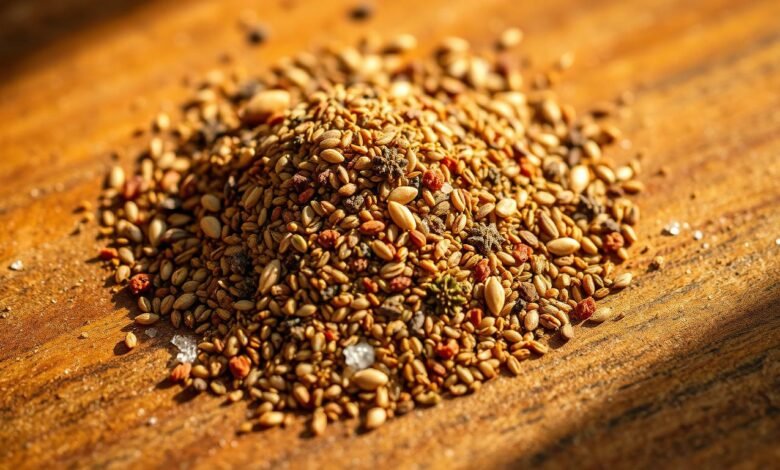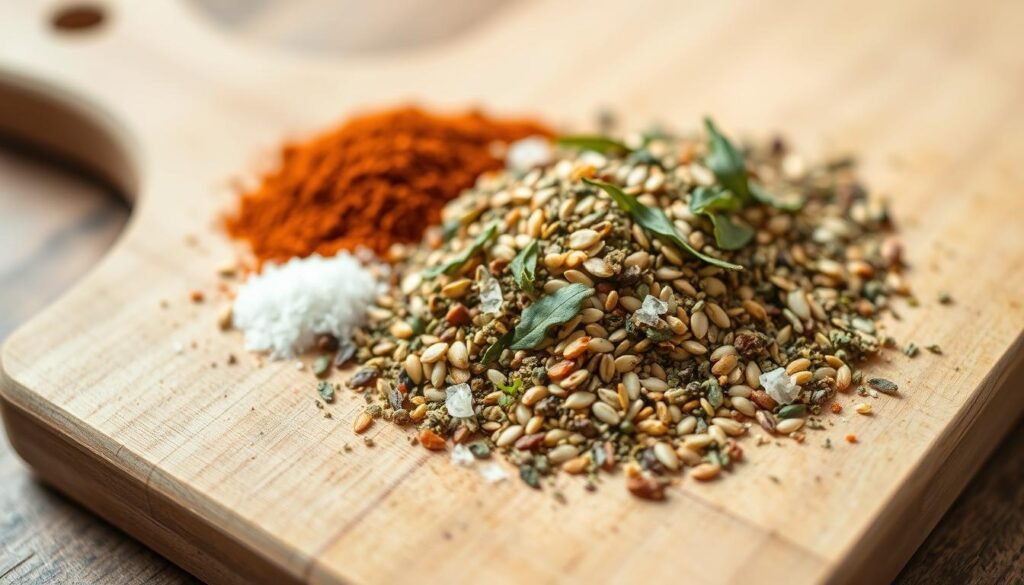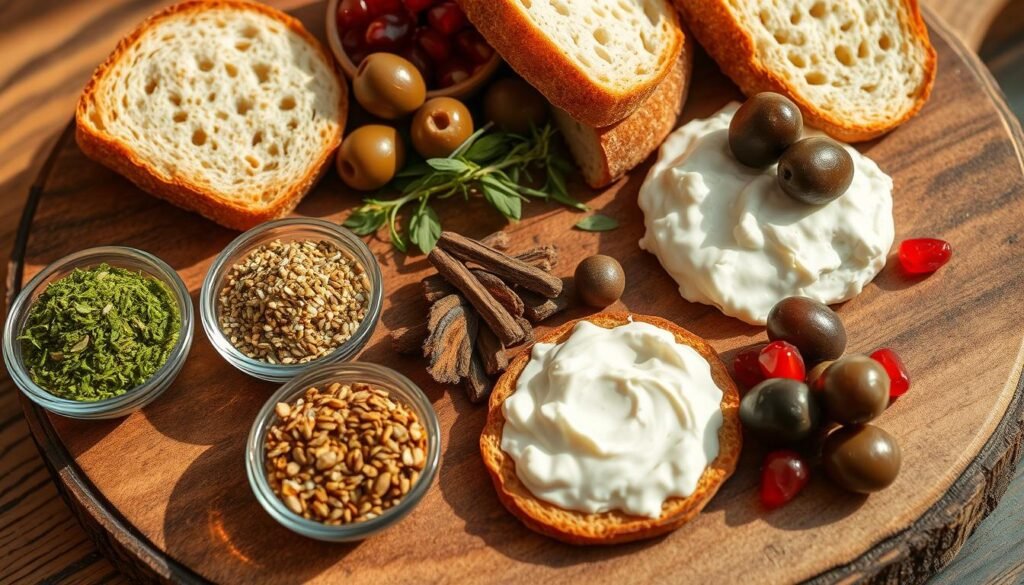
You may remember the first time a warm, herb-scented bite stopped you in your tracks. It might have been at a small market or from a friend’s kitchen, but that bright, tangy note—made richer by toasted seeds and a splash of olive oil—stayed with you.
This Middle Eastern blend brings those memories into your own kitchen. In just minutes you can mix dried herbs, sesame seeds, and sumac for a rustic seasoning that wakes up vegetables, meats, and dips.
Try it on hummus or baba ganoush, or brush olive oil on bread and sprinkle before baking. If you want a hands-on guide, see this simple recipe to get started right away.
Pay attention to aroma: it should feel earthy and bright. Too much thyme can turn bitter, so adjust the ingredients and store the mix in an airtight jar at room temperature to keep it fresh over time.
Key Takeaways
- You can make this Middle Eastern seasoning easily with common herbs and seeds.
- Sumac gives the blend its signature tang and pairs well with olive oil.
- Use it on hummus, baba ganoush, roasted vegetables, or brushed on bread.
- Toast cumin and coriander for depth, but avoid grinding sesame seeds.
- Store in an airtight container and watch for sesame rancidity over time.
Meet za’atar in your kitchen today
A quick mix of the herb blend with olive oil turns plain bread into a lively, shareable starter. You’ll whisk the dry blend in a small bowl or shake it in a jar and serve immediately with warm bread or pita.
One simple approach is to stir some of the za’atar spice into a shallow dish of olive oil for dipping. Another is to spread oil and the mix over dough and bake man’oushe for a bakery-style bite.
| Service | How to prep | Best for |
|---|---|---|
| Dipping bowl | Mix 2 tbsp oil + 1 tsp blend | Crusty bread, small groups |
| Man’oushe | Brush dough with oil, sprinkle blend, bake | Pita, snack or breakfast |
| Dry jar | Store blend in airtight jar | Seasoning for weeknight recipes |
Store the dry mix at room temperature. Freshness lasts roughly one to three months depending on the oil content of the sesame seeds and ingredient quality. Use these simple ways to fold this middle eastern seasoning into your weeknight recipes.
What is za’atar and how does it taste?
Za’atar is both a herb name and, more commonly today, a Middle Eastern blend that brings familiar Mediterranean herbs into one jar. You’ll find dried oregano, marjoram, and thyme at its base. Toasted sesame and sumac add nuttiness and bright tang.
Regional blend variations across the Middle East
Recipes change by country, town, and family. Some mixes stay strictly herbal with just sumac and sesame. Others add cumin, coriander, or local seeds for warmth.
Earthy, nutty, and tangy flavor profile
The overall flavor is herbal and earthy from dried herbs. Sesame gives a nutty richness that smooths sumac’s tartness. Bitterness should be mild and balanced.
- Core herbs: oregano, thyme, marjoram.
- Key accents: sumac for tang, sesame for body.
- Variations: cumin or coriander in some regional mixes.
| Region | Common tweak | Resulting note |
|---|---|---|
| Levant (Lebanon, Syria) | Higher sumac, lots of sesame | Bright and nutty |
| Palestine | Herb-forward, simple herbs | Earthy and herbal |
| Egypt | Often milder, sometimes cumin added | Warm, slightly spiced |
| Home blends | Family tweaks—salt or red pepper | Personalized balance |
zaatar spice ingredients you’ll need
Gathering the right ingredients sets the stage for an authentic Middle Eastern blend. You’ll keep the list short and focused so you can build flavor without hunting specialty items.
Core herbs and spices
For a classic mix, start with dried oregano, thyme, and marjoram. Add sumac for that lemony tang, toasted sesame seeds for nuttiness, and a pinch of salt to round the blend.
Optional additions
Consider warmed notes from cumin and coriander—toast whole seeds, then grind them for depth. Aleppo pepper adds gentle heat, and dried orange zest gives a floral lift.
Why sumac matters
Sumac is the key to the blend’s bright, tart profile. Use vivid red, freshly ground sumac to adjust tang before you finish the batch.
- Use toasted sesame, not ground sesame, to preserve nutty texture.
- Toast whole cumin and coriander, then grind for richer flavor.
- Favor Greek or Turkish oregano if you can; they match the middle eastern profile well.
- Make a small test portion to tweak sumac and salt to your taste.
| Ingredient | Form | Why it matters |
|---|---|---|
| Oregano | dried | Herbal backbone, earthy notes |
| Thyme | dried, lightly crushed | Green aroma; crush to prevent bitterness |
| Marjoram | dried | Sweet, floral balance to oregano |
| Sumac | ground | Tart, lemony lift—signature flavor |
| Sesame seeds | toasted whole | Nutty depth; oils bloom in mix |
| Salt | fine | Seasoning control; keep modest |
How to make za’atar at home
Making the blend at home only takes a few minutes and one small bowl. Start with dried herbs, sumac, sesame seeds, and a pinch of salt. Combine these in a bowl or jar and stir until evenly mixed.

Quick mix method
Measure your herbs into a bowl or a clean jar. Add the sesame seeds and salt, then mix well. This quick recipe takes just minutes and is perfect for a first batch.
Toast and grind for depth
For richer flavor, toast whole cumin and coriander until fragrant. Grind the warm seeds, then fold the ground pieces into your blend. Do not grind sesame seeds—leave them whole for texture.
Pro tips to finish
- Crush thyme lightly so it disperses without large bits.
- Taste and adjust salt and sumac to suit your palate.
- Warm the mix briefly in a dry skillet to bloom aroma if using right away.
- Label and store in an airtight container near the stove for easy reach.
Ways to use za’atar right now
Brighten weeknight meals by keeping a jar of the mixture handy. You’ll find many easy ways use it to add immediate aroma and depth.
With olive oil on pita, man’oushe, and bread for dipping
You’ll make man’oushe by mixing za’atar with olive oil and spreading it on pita before baking for a toasty flatbread.
Set out one bowl of olive oil and one of the dry mixture so everyone can dip bread to taste.
Over labneh, hummus, baba ganoush, and roasted vegetables
Drizzle the blend over labneh, hummus, or baba ganoush for instant tang and nutty texture.
Toss roasted vegetables with a little olive and the mix right after the oven so the sumac stays bright.
As a marinade, rub, and quick snack topper
Whisk the mixture into olive oil and lemon for a fast marinade, or use the dry rub on meats, seafood, and kebabs.
You’ll also sprinkle it on salads, grains, eggs, popcorn, and roasted chickpeas for an easy flavor boost.
- Finish pizzas, avocado toast, and soups with a final pinch.
- Dust snacks like popcorn to highlight sesame seeds and sumac.
- Keep a small cup near the stove to shake over greens or halloumi at the last minute.
Perfect pairings for maximum flavor
A few smart matches turn this herb mix into the star on your plate. Use these pairings to build quick meals that taste balanced and bright.

Dairy and vegetables
Soft cheeses like labneh, goat cheese, and feta let the herbs and sumac shine. The creaminess tempers acidity and makes each bite silky.
Roast eggplant, tomatoes, or cauliflower until tender, then finish with a light sprinkle. The warm veg picks up aromatic notes and becomes deeply savory.
Carbs, acid, and fats
Use warm pita, rice, or quinoa as a neutral canvas. A drizzle of olive oil and a squeeze of lemon carry the mix across the dish.
Match olives and extra oil to echo Mediterranean character. Add fresh parsley, mint, or cilantro for lift, and consider pistachios for crunch in grain bowls.
- Taste and tweak acid and salt at the end to keep the overall flavor vivid.
- Apply these ideas across simple weeknight recipes and composed salad bowls for easy restaurant-style results.
Storage, shelf life, and freshness
Keep your jar in a cool, dark spot so the aroma stays bright and clean. Store the dry blend in an airtight container or jar away from heat and light to protect delicate oils and herbs.
Airtight containers, cool dark place, and ideal time window
You’ll use the mix within a short time for best results. Aim to finish it in 1 to 3 months for peak taste.
Freshness checks: aroma, sesame rancidity, bitterness balance
Check the scent before use. Good za’atar should smell earthy and lively.
If the sesame or toasted sesame notes smell oily or off, discard the batch. A sharp, lasting bitterness can mean too much thyme.
Olive oil ratio and when to mix ahead
Keep the dry mixture separate from oil. Mix with olive oil only when you plan to use it.
- For a spread: two parts mix to one part oil.
- For a drizzle: use equal parts.
- Avoid pre-mixing unless you’ll use it within a week.
| Storage item | Where to keep | Use-by time |
|---|---|---|
| Dry mix in container | Cool, dark cabinet | 1–3 months |
| Mix with olive oil | Refrigerate if kept | Use within 7 days |
| Toasted seeds / whole spices | Separate jar | 6 months (label date) |
Nutrition notes and easy substitutions
A short nutrition snapshot helps you balance flavor and health when seasoning food.
Light nutrition overview and sodium awareness
A 1/2 tablespoon serving has about 17 calories, 1.6 g fat, 0.8 g carbs, 0.3 g protein, and roughly 88 mg sodium.
Salt content varies by recipe and added salt. Reduce salt in the mix if you plan to serve it with salty cheese or brined olives.
Substitutions: herbs and lemony swaps
If you don’t have marjoram, boost oregano to keep the herbal profile intact.
When sumac is unavailable, use a lemon-forward alternative like lemon salt or a light squeeze of lemon, knowing the flavor will shift.
- Use toasted sesame seeds for flavor without extra fat.
- Sprinkle the mix over eggs, salads, or roasted vegetables for low-calorie impact.
- Note allergens: sesame is a common concern—offer an alternative topping if needed.
- Taste small test batches and record your preferred ratios so you can reproduce favorite versions for future recipes.
| Nutrient / Note | Per 1/2 tbsp | Practical tip |
|---|---|---|
| Calories | ~17 kcal | Great for finishing dishes without many calories |
| Fat | 1.6 g | From sesame; toasty flavor, modest fat |
| Sodium | ~88 mg (variable) | Cut added salt if pairing with salty items |
zaatar spice
A simple bowl and a few pantry ingredients are all you need to craft this aromatic blend.
Define it: This classic Middle Eastern blend pairs dried oregano, thyme, and marjoram with toasted sesame seeds, ground sumac, and a pinch of salt. You can make it in minutes and keep the sesame seeds whole for texture.
How to mix: Measure the dried herbs into a bowl, add sesame and salt, then stir until even. If you choose to add whole seeds like cumin or coriander, toast briefly and grind them before folding in.
Serve and use: Stir a little into olive oil and brush on pita or bread, or sprinkle the dry mixture over labneh, hummus, baba ganoush, and roasted vegetables as a finishing touch.
Versatile roles: Use the blend as a dry rub, a marinade starter, or a last-minute garnish on salads and grain bowls. Adjust oregano, thyme, and marjoram ratios to match your taste.
- Keep small batches to preserve aroma and nutty notes.
- Store in an airtight jar away from heat and light.
- Look for vibrant color and a lively scent as freshness cues.
| Step | What to do | Why it matters |
|---|---|---|
| Combine | Mix herbs, sesame, sumac, salt in a bowl | Even flavor and preserved texture |
| Optional toast | Toast whole seeds, then grind | Added depth without crushing sesame |
| Serve | Brush with olive oil on pita or sprinkle on dips | Brightens breads, labneh, hummus, and vegetables |
| Store | Airtight jar, cool dark spot | Keeps aroma for weeks; use within 1–3 months |
Conclusion
Bring your jar to the table and let guests season bites to taste for an easy, shared finish.
You’ll walk away with a simple recipe that takes just minutes to mix and instantly upgrades savory dishes. Store the dry mix in an airtight container at room temperature and keep a small container by the stove for everyday use.
Make the olive oil mixture only when you need it and use it within a week. Serve with warm pita and a shallow dish of oil, or sprinkle the dry blend over dips, salads, and roasted vegetables.
With this core mixture on hand, you’ll try new recipes, track your favorite ratios, and keep freshness front of mind so the tang from sumac and nuttiness from sesame seeds stay bright.